The Portfolio Overview page shows you the current performance and progress of a Portfolio, with all its associated Folios and Portfolios.
The main page or Dashboard is subdivided into seven sections: Traffic Light Indicators, Progress, Portfolio Overview | PortfolioOverview Roadmap, Portfolio Overview | PortfolioOverview Finance, Portfolio Overview | PortfolioOverview Staff, Additional Information and Portfolio Overview | PortfolioOverview Notes.
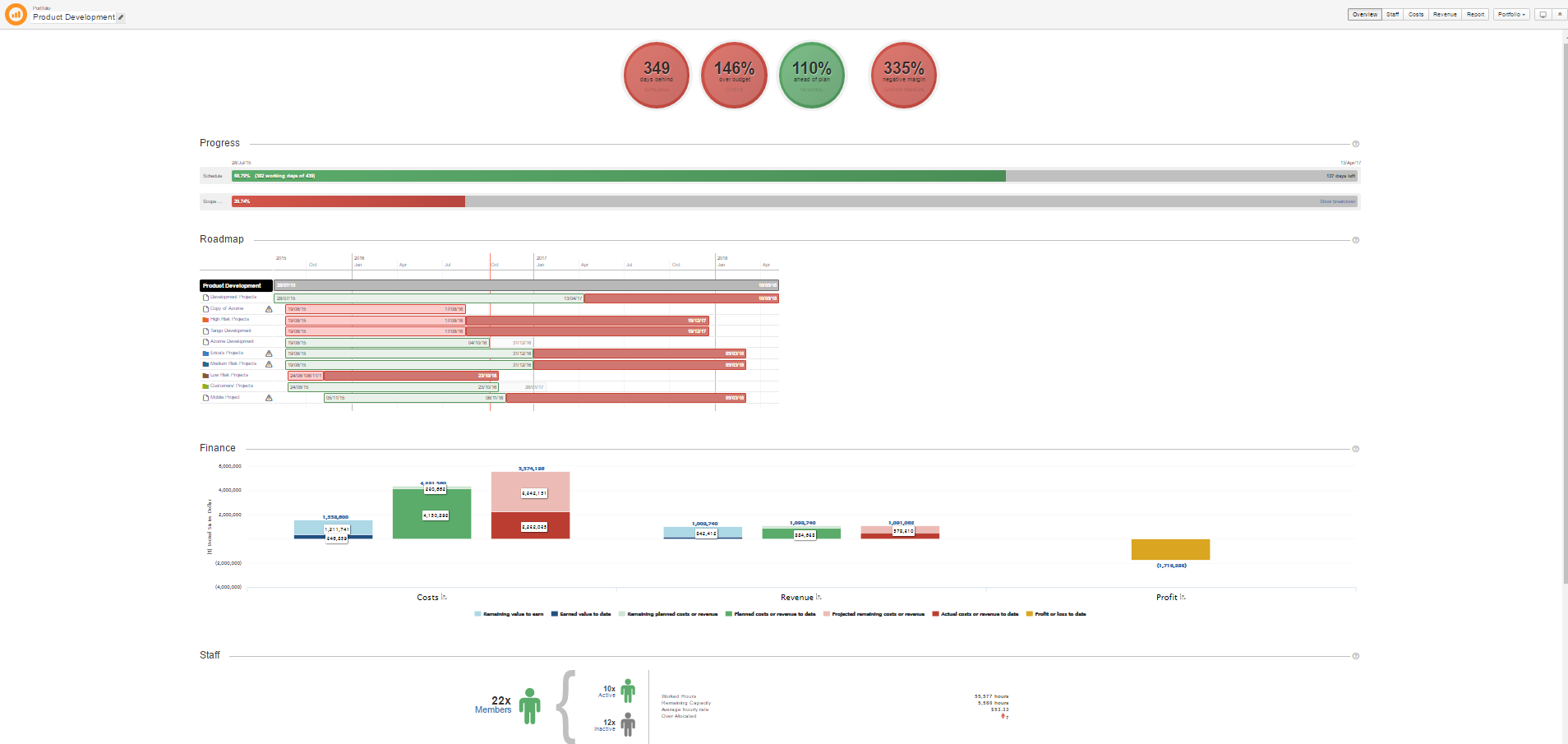
Note that when loading the Portfolio Overview page all sections are collapsed on the Dashboard:
-
Click the arrow head by each title to expand the required sections. Click again to collapse.
-
Set your default preference (expanded or collapsed) for each section. Click the pin on the right-hand side of the title, to set as default.
To refresh the data in the Dashboard, click the Refresh Cache (Refresh Current Portfolio) button. The data is refreshed from cache asynchronously and when completed displays a timestamp in the tooltip.
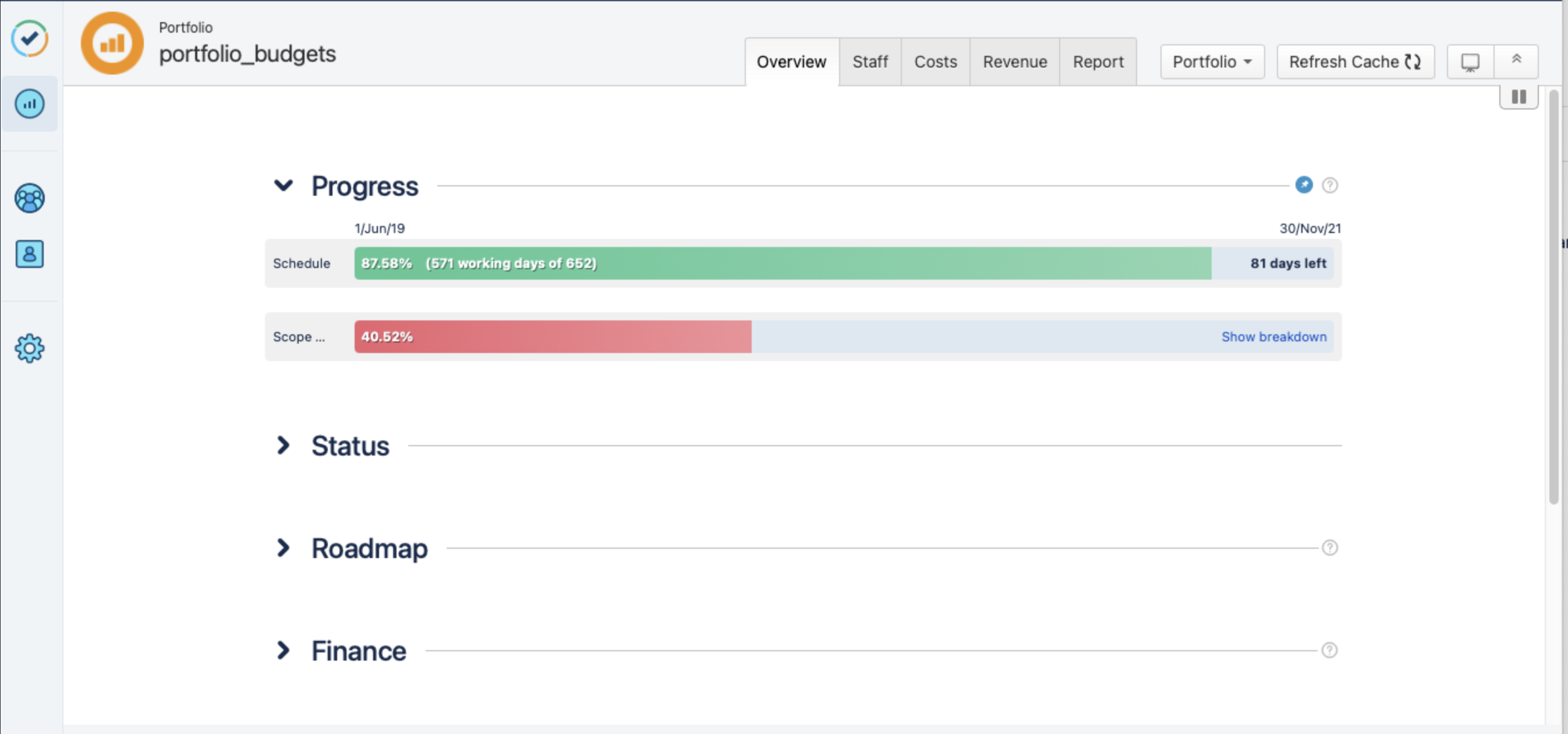
The Header shows you the name of the selected portfolio and gives you access to detailed information on its staff, costs, revenue and available reports.

Traffic Light Indicators
The following table describes the traffic light indicators on the Portfolio Overview page:
|
Traffic Light |
Information |
|---|---|
|
Schedule |
The difference between the planned and projected dates. If there are several folios available in the portfolio, the number displayed reflects the worst schedule performance among the folios in this portfolio. |
|
Costs |
The percentage of variation between the budget and the actual cost to date. The percentage displayed is the sum of the actual costs to date of all folios in this portfolio compared to their total planned costs and multiplied by their completion ratio. |
|
Revenue |
The percentage of variation between planned and actual revenue to date. The percentage displayed is the sum of the actual revenue to date of all the folios in this portfolio compared to their total planned revenue multiplied by their completion ratio. |
|
Profits/Gross Margin |
The gross profit margin to date. The percentage displayed indicates the total profit to date divided by the total revenue to date. |
The system uses the following color scheme to indicate status:
-
Green: On track. All aspects of portfolio viability are within tolerance.
-
Amber: Some issues are having a negative effect on the portfolio. Viability is at risk
-
Red: Problematic. Serious, high-risk concerns are threatening the overall performance of the portfolio.
-
Grey: No data available for the time being
If all the folios within the portfolio use the Earned Value Management (EVM) functionality, you hover your cursor over the ellipsis of the traffic light to obtain more at a glance information.

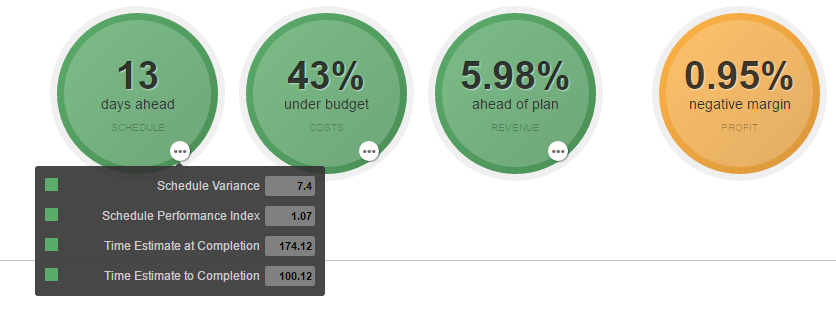
You can also click the traffic light to drill down and obtain more detailed information on this particular area of the portfolio.
Progress
This section compares the schedule and the scope completion progress.

-
The Schedule progress bar displays the workings days elapsed/remaining working days in the planned portfolio time-frame.
-
The Scope progress bar displays the completion ratio. For example : how much progress has been made completing the issues that are part of this folio's scope.
Note: The Scope progress becomes red if lower than the Schedule progress.
Click the Show/hide breakdown link of the Scope progress bar to display or hide the scope completion of each element of the portfolio:
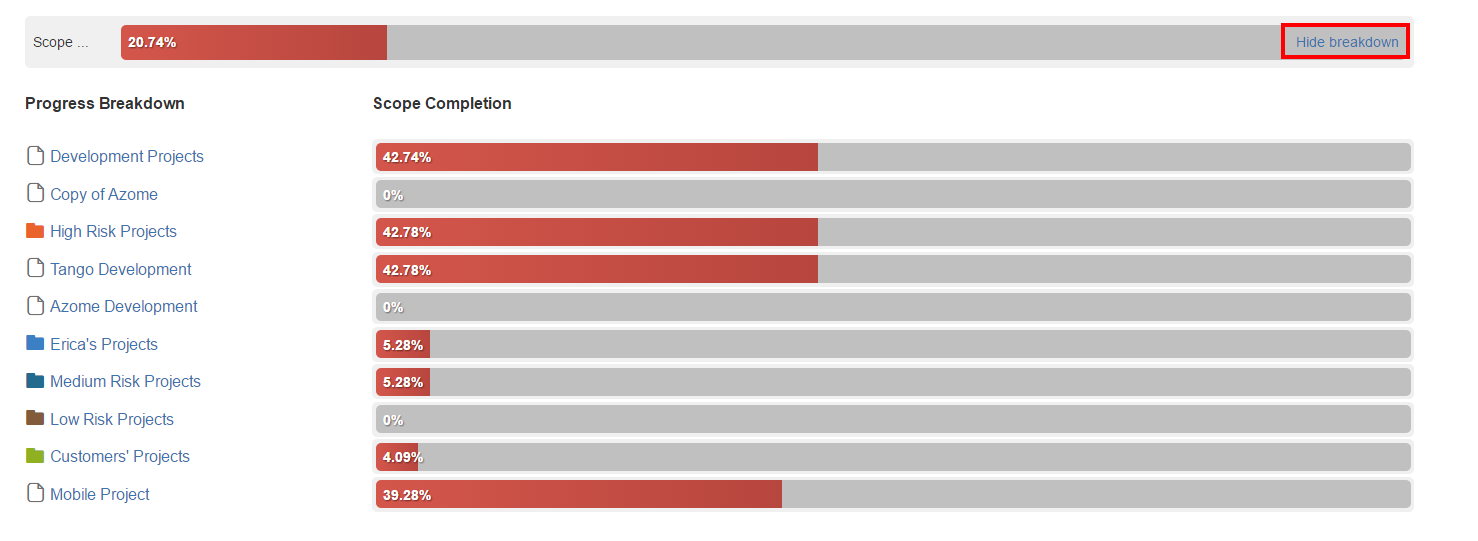
Click the folder or folio in the list to view its dashboard.
Roadmap
This section displays a timeline to illustrate the roadmap of all the folios included in this portfolio. It indicates the planned timeframes of each folio and portfolio as well as its projected due date according to current schedule performance.
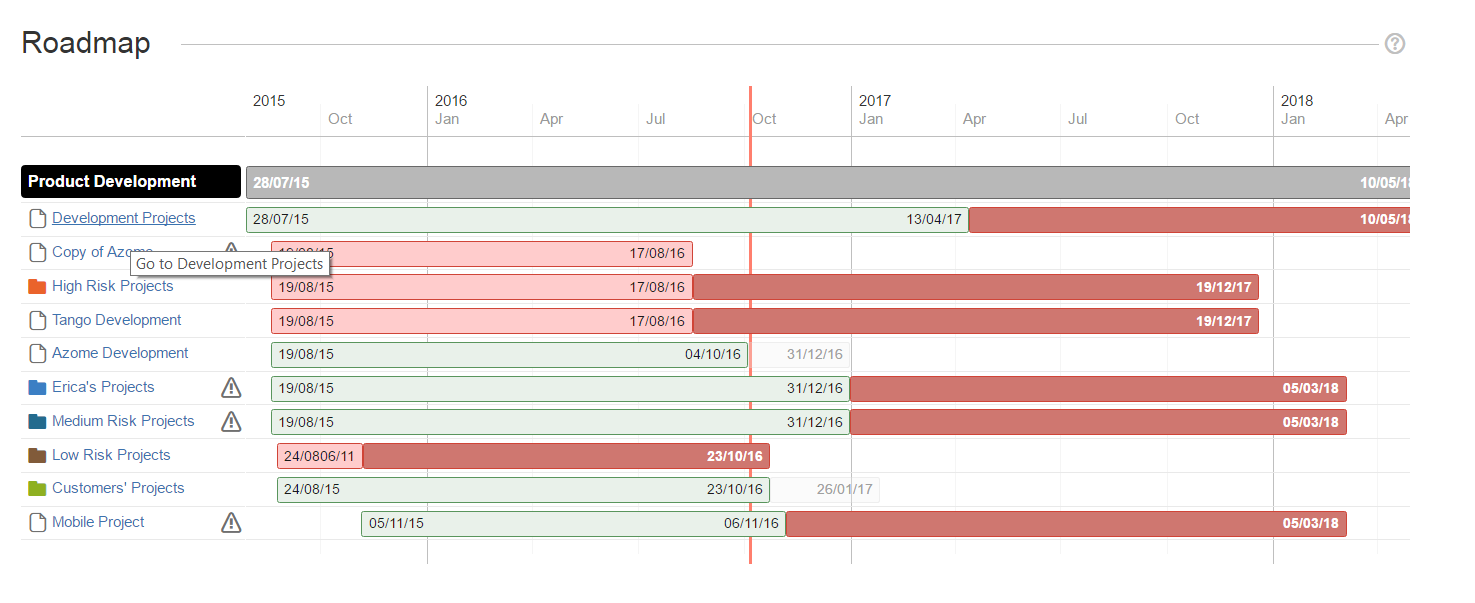
Folios or portfolios that are over budget are identified using the 
1. The red vertical line indicates the current date.
2.Click the folio or folder to view its dashboard.
3. Click the planned time frame of a folio or portfolio to display more information on it:
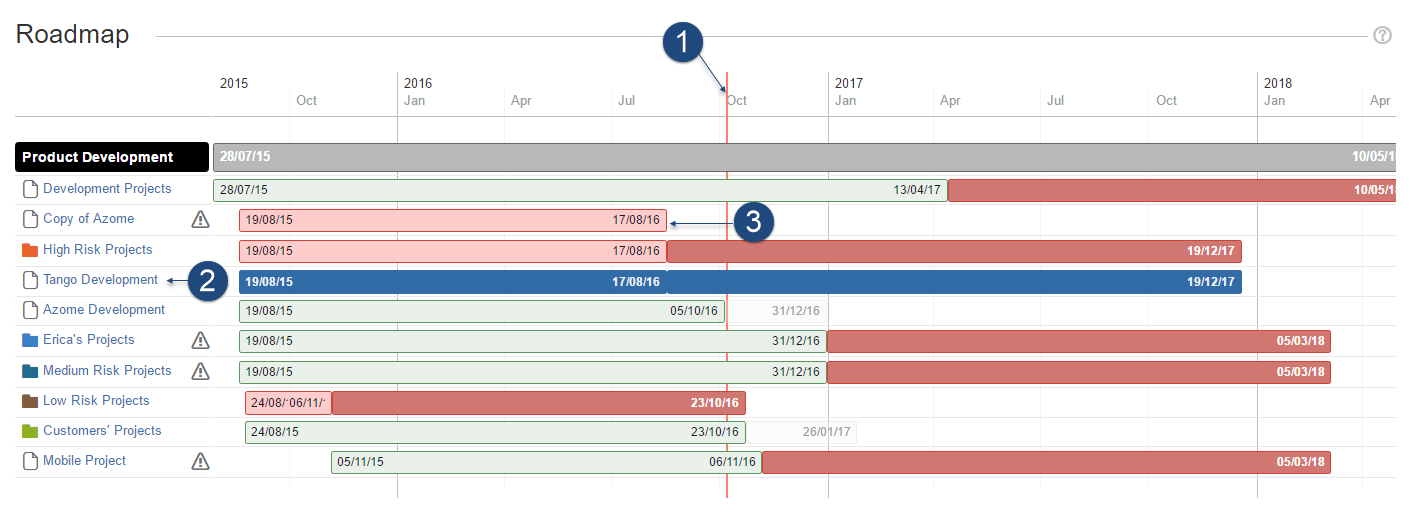
You can then click the traffic lights (4.) and values in the Planned and Cost columns (5.) to drill down for more information.

Finance
This section displays two charts which provide the current financial picture of the portfolio. The first chart bars allow you to compare various values to date (bright bar portions) along with projected values at completion (pale bar portions), such as estimated costs or revenue at completion.
The second chart shows you the evolution over time of various amounts, showing trends and projections. That chart can be toggled in three modes: Costs, Revenues or Profits, each one showing the relevant curves.
Finances to Date: Bar Chart
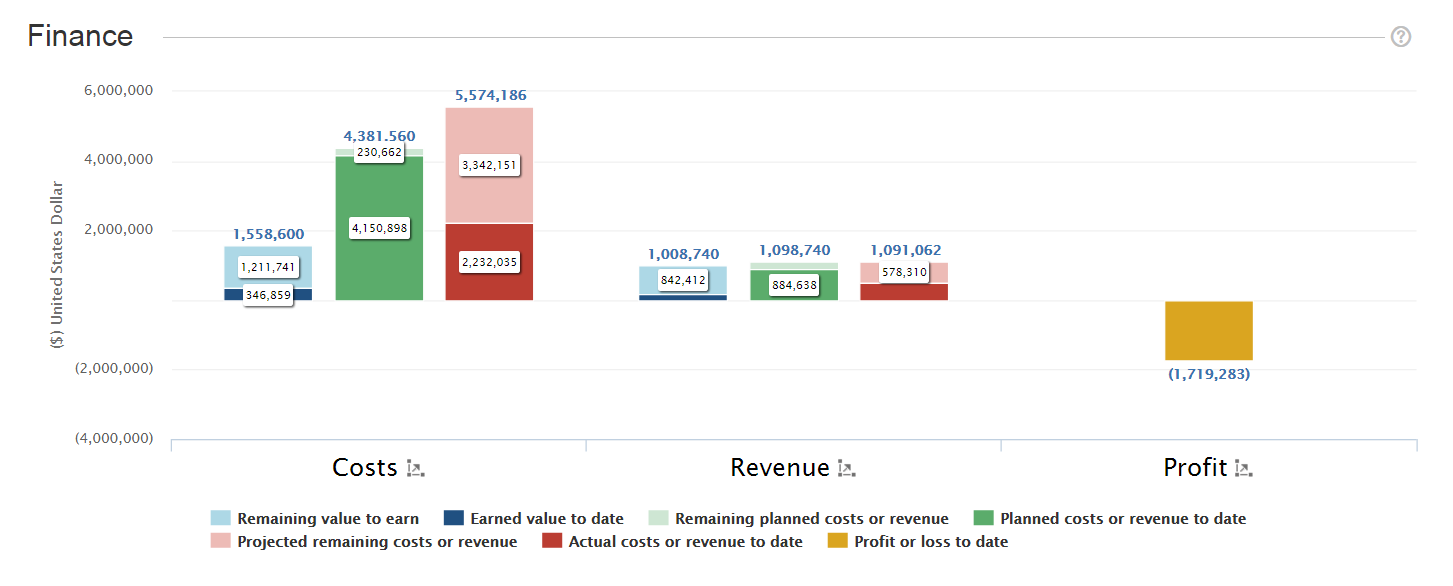
The following table describes the metrics displayed in the Finances to date chart: each bar is colour coded to represent a specific metric.
|
Metric |
Definition |
|---|---|
|
Remaining value to earn |
The sum of the remaining value to earn for all EVM folios in this portfolio. |
|
Earned value to date |
Earned value to date is equal to the total earned value of all EVM folios in this portfolio. |
|
Remaining planned costs or revenue |
total remaining planned costs or revenues to date for all the folios in this portfolio. |
|
Planned costs or revenue to date |
Indicates the sum of the planned revenue of all then folios in this portfolio that should have been realized to date or the total planned costs to date for all folios in this portfolio. |
|
Projected remaining cost or revenue |
The sum of the forecast based on prior sales numbers and anticipated increases in expense. |
|
Actual costs or revenue to date |
Indicates the sum of the actual costs to date of all the folios in this portfolio. |
|
Profit or loss to date |
Indicates the profit or loss to date for all the folios in this portfolio. |
Click the values above the bars and numbers to go to the corresponding screen (Cost/Revenue summary or forecast)
Click the icons next to the X-axis labels to go to the corresponding forecast chart which shows the detail over time for the whole time frame.
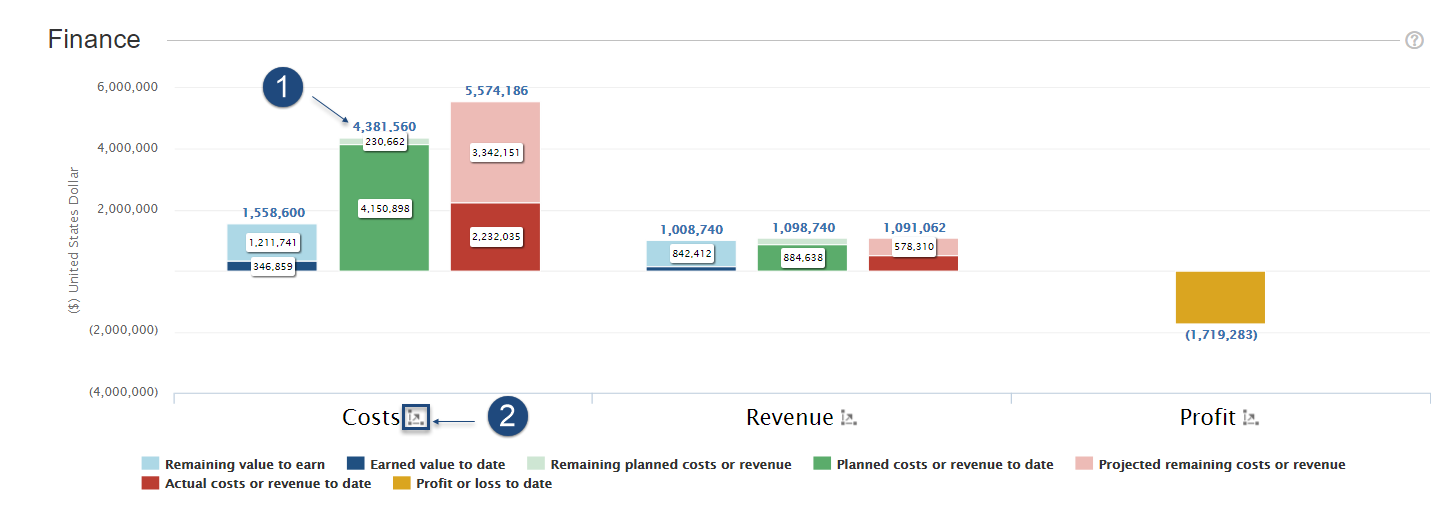
Finance trend: Line Chart
The line chart in the Finance section shows the trend over times of costs, revenues and profits, both planned and actual. A dashed vertical line indicates today's date. Past values appear as solid lines while projected values appear as dashed lines. Hovering one of the lines of the chart displays a tooltip with precise values for that specific date. For more in-depth trend and forecast information, visit the Forecasts pages (Costs > Forecast and Revenue > Forecast) of the portfolio. You can show/hide details in the chart by clicking the agenda labels.
The Costs view of the chart compares planned costs, actual costs and costs earned value (blue).
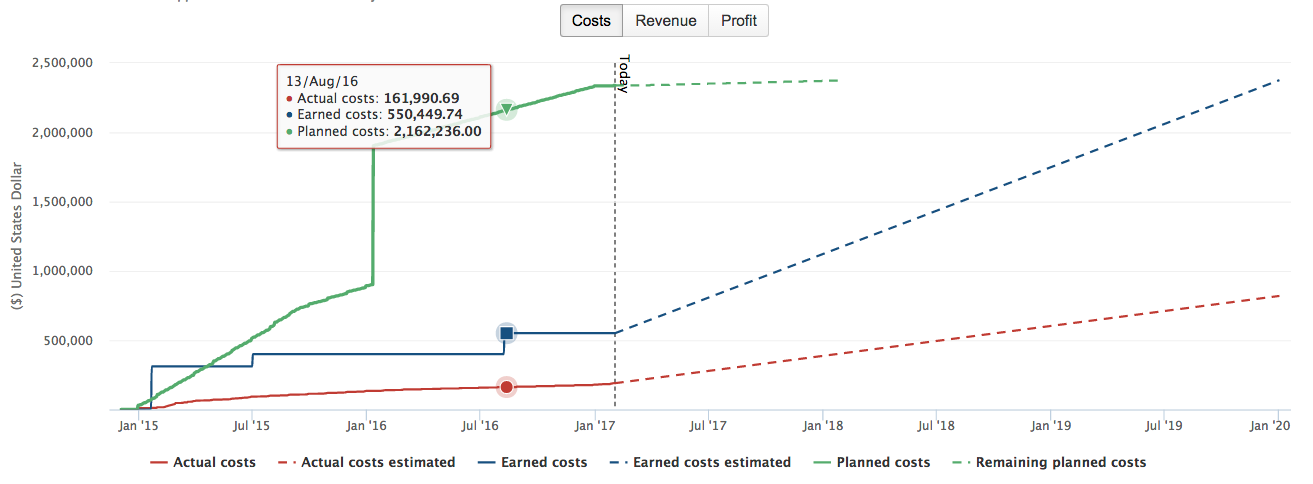
The Revenue view of the chart compares planned revenues (green), actual revenues (yellow) and revenues earned value (blue).

The Profit view of the chart compares actual costs (red), actual revenues (orange) and profit (yellow).
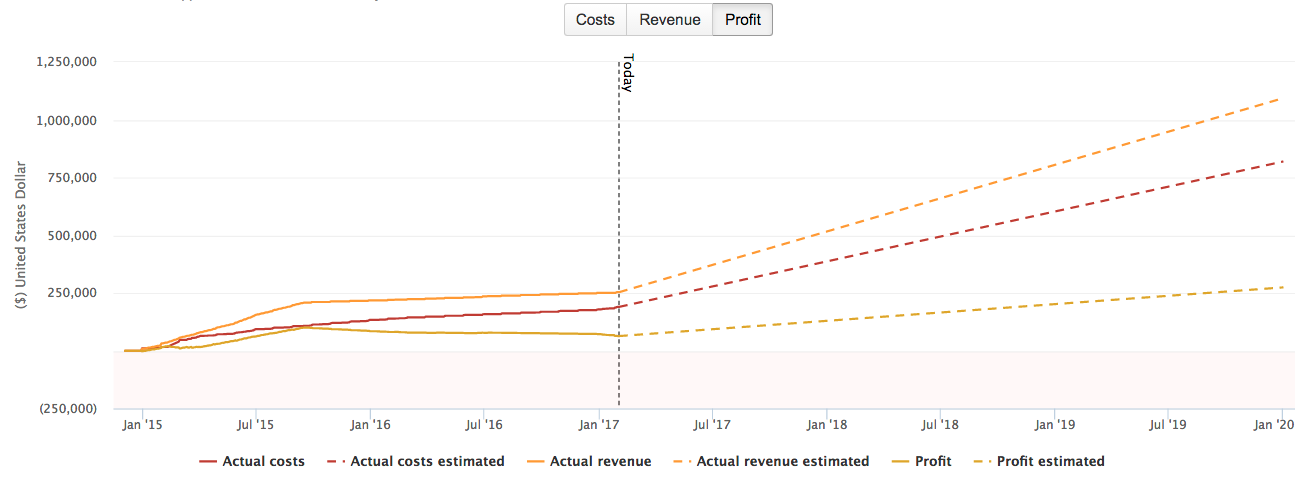
Staff
This section gives you an overview of the current state of the portfolio's staff. The staff activity status and remaining capacity is based on each member's availability.

The section on the right side of the screen provides the following information on the members assigned to this portfolio:
|
|
|
|---|---|
|
Worked hours |
Indicates the total sum of worked hours to date for the allocated members. |
|
Remaining Capacity |
Indicates the total remaining capacity of all staff members until the planned end date, based on their specified availability. |
|
Average hourly rate |
Current average cost rate weighted by the current availability percentage of all active staff members. |
|
Over allocated |
The number of over allocated members, meaning: the number of members whose total specified availability for all folios in this portfolio is greater than 100%. |
1. Click the Members link to display the the Portfolio Staff summary capacity chart.
2. Click the Active or Inactive link to display information on the Staff Members.

Additional Information
This section displays additional information about the Portfolio (such as: the currency used, the project owner, etc.) and lets you enter a description by clicking the Description field.

Note: Whether or not you can modify the specified information in this section depends on your user rights.
Notes
This section lets you add additional notes.

To do so:
1. Click Add a note.
2. In the Add Note dialog, enter the note then select the level type from the drop-down. The default is 'information'.


